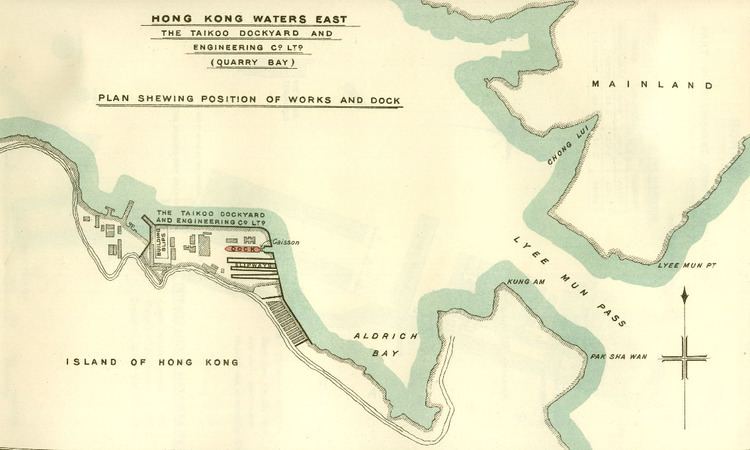Address Taikoo Shing, Hong Kong | ||
 | ||
Similar Grand Promena, 7‑Eleven ‑ Lei King Wan Tai, 太古城物業管理公司, Taikoo Place | ||
Taikoo Dockyard and Engineering Company (Chinese: 太古船塢) was a dockyard in what is now Taikoo Shing, MTR Tai Koo Station and part of Taikoo Place of Quarry Bay on the Hong Kong Island in Hong Kong.
Contents
History
The idea that John Swire and Sons should have their own dockyard in Hong Kong to service, repair, adapt and build vessels for The China Navigation Company was first put forward when the Sugar Refinery was established at Quarry Bay and surplus land remained on that site. The suggestion was made several times in the late 19th century but was opposed by John Samuel Swire as uneconomic and too far outside their usual interests.
The need, however, for adequate, reliable and easily available overhaul facilities in the East increased and the dockyard was eventually begun in 1900–01 at Quarry Bay. It was registered in Britain with John Swire & Sons appointed as London Managers, Butterfield & Swire Eastern Managers and Scotts Shipbuilding and Engineering Company as expert advisers.
The first ship for CNCo was built by 1910, but it was 16 years before there was a profit on the working account and 20 before a dividend was declared. The dockyard's chief competitor was the Hong Kong and Whampoa Dock Company from whom the new firm faced considerable hostility for many years until a working agreement was reached between them in 1913.
Beginning in Colonial Hong Kong, Whampoa Dockyard Company and "Taikoo Dockyard and Engineering Company" were crucial for the economy. Together with the United Kingdom, these two docks in Hong Kong built the largest ships in the world in that era.
Simultaneously, China had multiple dockyards such as Shanghai Dock and Engineering Company in 1906, Tung Hwa Shipbuilding Works in 1910 and the Shanghai Dockyards Ltd in 1937. Though Hong Kong's dockyards always gave the British complete freedom in ship construction.
In the 1930s Shanghai experienced difficult times through events such as the Battle of Shanghai in the Second Sino-Japanese War. Hong Kong's Taikoo Dockyard continued its own government training schools, which were later superseded by Hong Kong's Technical College.
By the Second World War other countries finally began building larger ships than Hong Kong.
In 1940 the British company went into voluntary liquidation so that a new one could be opened and registered in Hong Kong and the dockyard continued to expand after the Second World War despite the destruction caused by the Japanese in their occupation in 1942–45.
The Swire Group subsequently decided to use the land to develop a large private housing estate, Taikoo Shing. Closing in the early 1970s, the operation later merged with Whampoa Dockyard of Hutchison Whampoa to form a Hong Kong United Dockyard at the west coast of Tsing Yi Island on the western shore of new territories.
